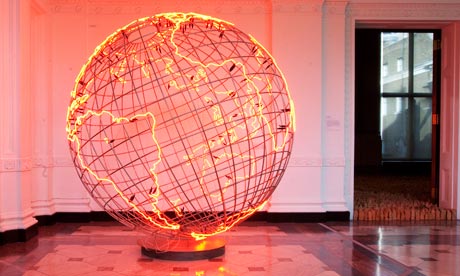2012年艺术现状大会概况
伦敦艺术大学广州招生代表处 | 2012-03-01
State of the Arts Conference 2012 – Preview
2012年艺术现状大会概况
400位资深艺术家和艺术经理人齐聚索尔福德的劳里,出席2012年艺术现状大会,探讨艺术领域存在的现实问题,碰撞最新的思想火花,塑造艺术未来。该大会每年举办一次,今年来到第三届,本届由英国艺术委员会和 BBC 共同主办。大会搭建了艺术机构间交流的强大平台,整合资源,促进分享,为艺术机构和从业者不断开辟新的渠道和空间。
What can 400 artists and arts managers expect when they head to the Lowry in

How will artists be shaping the future at State of the Arts 2012? Pictured: Hot Spot by Mona Hatoum, 2006. Photograph: David Levene
A high-level and timely intervention from the Arts Council (ACE), the State of the Arts conference is aimed at senior arts professionals and intended to provide a collective space to discuss current issues and the latest thinking within the sector. It's a slightly curious affair that it is entirely establishment, hosted this year by ACE in partnership with the BBC, with a British Council reception at the close on 14 February.
One benefit of being so very establishment is that it can provide a powerful platform. As examples, the 2011 event formally introduced the concept of crowdfunding through the lovely Ed Whiting of We Did This. It also allowed Peter Bazalgette to introduce the idea of artist-and-arts-organisation generated content for an online arts channel available via TV. This has found shape as The Space initiative, a £
Last year, the minister for culture, communications and creative industries, Ed Vaizey, made a keynote speech that dominated the day. He spelled out what he expected from arts managers – largely the greater and better use of digital technologies, and collaboration as a partial solution to reduced budgets. Both of these led to baffled head-scratching since many organisations had already been collaborating considerably for quite some time. The subject was returned to repeatedly throughout the day: what did "more collaboration" actually mean?
The call for greater use of digital technologies was also picked over. It was acknowledged that organisations could improve themselves digitally, even at a basic level, with better websites and more in-house knowledge of potential uses and applications. But there was also a sense that digital is not necessarily an appropriate or cost-effective medium for all organisations and that developing bespoke digital solutions is very expensive. The subsequent over-subscription into the ACE-AHRC-Nesta Digital R&D Fund for Arts and Culture does suggest, however, that there is a huge sector appetite to incorporate digital technologies into their core practice. If the money is there to do it.
So what can delegates expect from State of the Arts 2012? There are a few changes from the 2011 format. For a start, it's taking place outside
The programme is extensive, with keynote speeches, a stage interview and nine parallel thematic panel events, of which delegates will only be able to attend two each. As with many conferences, it's trying to cover a lot of ground in a short space of time. The danger is that this can discourage depth of discussion, wide participation and the ability to make cross-thematic connections. How can this be avoided, I wonder?
One key criticism of 2011 was the almost total absence of an essential sector constituency – the artists! A very small number had been invited to "perform" but the time and place set aside was in the coffee room during breaks, against a background of furious networking and without an MC to direct attention their way.
A few came as delegates – David Cotterrell and Bobby Baker, for example – but the £100 ticket price, along with travel and possible accommodation costs probably mitigated against a significant artist presence. ACE is sensibly avoiding a repeat of this situation by providing 50 artist bursaries for 2012. They are also commissioning the Manchester International festival to curate an evening of pre-conference arts events on the 13th – likely to be a welcome and inspirational start to the experience.
Although places are limited, the great strength of State of the Arts is in being a national event, bringing together many of the most talented, knowledgeable, experienced and influential people across the sector. It's an opportunity for many strands of the sector to formally and intelligently speak to each other and – perhaps – to the government.
Given that this is an ACE event, and that Vaizey is again a keynote speaker, it is also likely to be used for a top-down communication of national arts policy and priorities, which many will find useful. The challenge is whether it can succeed in assimilating and being influenced by not just the delegates, but alternative voices and perspectives. For example, via the live blogging platform set up by Andy Field and Hannah Nicklin, now online for pre-conference contributions.
I also hope the 50-plus artists present make their voices heard by doing what they are so very good at: asking the questions that other people don't, stimulating argument and demanding thoughtful responses.
(英文信息来自伦敦艺术大学)